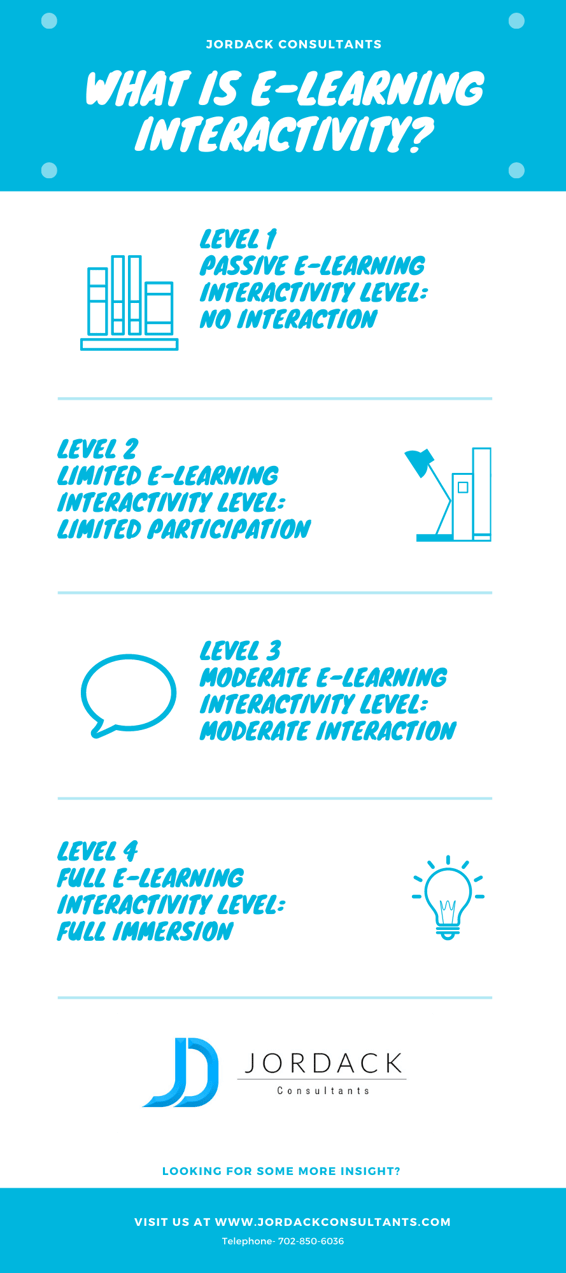Industry Insights
What Is e-Learning Interactivity and Why Is It So Important?
E-Learning interactivity is defined as the “dialogue” between learners and e-Learning tools through which learners become engaged and involved in the e-Learning process. It is a key element of the actual e-Learning course design process, and it has proven to be a practice that adds outstanding value to your e-Learning course. It involves forms of action or reaction on learners’ behalf, in order for them to achieve results or reach a conclusion. e-Learning interactions may include multiple choice quizzes, tests, e-Learning scenarios, simulations, animation videos etc, that help learners to deepen their understanding of the subject matter through experimentation, dealing with unpredictable circumstances, or even learning from their mistakes.

The e-Learning Interactivity Levels
The e-Learning interactivity levels are defined based on the extent of interactivity in the e-Learning process. With this in mind, there are four main e-Learning interactivity levels:
- Passive e-Learning interactivity level: No interaction
Learners are not required to interact with e-Learning resources and the e-Learning process is strictly linear. This level may include: simple images and graphics, simple video and audio, test questions, etc. - Limited e-Learning interactivity level: Limited participation
Learners may have some control over their e-Learning experience, as they are required to make simple interactions with the e-Learning material. This level may include: animations, clickable menus, drag and drop interactions, and multimedia. - Moderate e-Learning interactivity level: Moderate interaction
Learners gain more control over the e-Learning experience, which is more customized and complex. This level may include: animated video, customized audio, complex drag and drop interactions, simulations, stories and branching scenarios and multimedia. - Full e-Learning interactivity level: Full immersion
Learners have great control over their e-Learning experience, as they are required to fully interact with the e-Learning content and give feedback. This level may include: interactive games, simulated job performance exercises, customized audio or videos, avatars, stories and scenarios, as well as multimedia.
The e-Learning Interactivity Benefits
As e-Learning professionals, our goal is to engage and inspire learners, in order to result in enhanced learning outcomes. We also know better than anyone that developing and designing a high quality e-Learning course is not enough, unless we succeed in engaging and motivating our audience to learn. e-Learning interactivity has been proven to activate long-term memory and to improve attention, which are both essential parts of all learning mechanisms. But there are certainly some more key benefits to keep in mind.
-
-
- It causes reaction.
e-Learning interactivity can replicate real world through the usage of e-Learning course scenario questions and simulations that provide learners with the opportunity to make decisions without taking real risks. When learners are forced to think about applying what they know from the e-Learning experience to an actual situation, they are encouraged to explore what will happen in case they succeed or fail. This is particularly true in online training courses; when employees are able to create their own action plan in a risk-free and non-judgmental environment, they can experiment with unpredictable paths with no stress involved, so when it’s time to face the actual problem or the actual customer in the real world, they will be able to handle complex tasks with a high rate of success. - It encourages reflection.
When learners are required to respond to what they are learning, for instance when a question or activity makes them stop to think in order to consider the answer or choose a path in the e-Learning process, they are able to integrate the e-Learning content into their own way of thinking. This way, the e-Learning experience encourages their involvement, as depending on their response, correct or incorrect, they receive feedback, which is a key element in any interactive mechanism. - It boosts engagement.
Every experience causes reactions; powerful stories and provocative questions create cognitive notes and allow us to immerse these notes deeply in our minds. Interactive activities engage learners in the learning process by directing their attention to the e-Learning content, resulting in better learning outcomes. Furthermore, when learners have the ability to control their e-Learning process, for instance in learner-centered online training, which is a perfect framework for e-Learning interactivity, they can be more motivated and engaged. - It enhances knowledge retention.
Interactive activities create curiosity, and curiosity leads to better knowledge retention. Multimedia elements, scenario-based cases, even achievement awards, have the power to transform the dullest e-Learning course into an engaging, emotionally driven, and, most importantly, memorable e-Learning experience. Encourage your learners to put their learning to use while thinking, exploring and evaluating the outcomes based on their decisions and you will be able to offer them an effective, compelling experience that has greater potential to be retained. - It promotes motivation.
“Fun” elements like multimedia, interactive scenarios and games motivate learners to participate more willingly in the e-Learning process. The more interesting is a story or an e-Learning game, the more intensive will be your learners’ motivation. An opportunity for reflection, such as a provocative question that makes learners stop and think, motivates them much more than simply clicking on a “next” button. Furthermore, when e-Learning interactivity is used in mobile learning, which enables your audience to participate in your e-Learning course anytime, anywhere, learners are more likely to be motivated to fit the e-Learning course experience into their busy schedules.
- It causes reaction.
-

